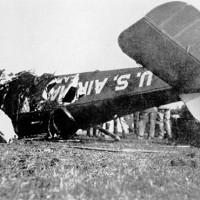A Short Story; A Long History: An Airmail Pilot's Wild Night Over Peoria
- Details
- Published on Tuesday, 05 March 2013 09:04
- Written by Ken Zurski
The young airmail pilot was falling head first when he pulled tightly on the rip cord and hoped for the best. Suddenly the risers whipped around with a jerk and the free falling weight at the bottom of the harness snapped back into an upright position. The chute was open. But a more precarious threat lay just below. The pilot placed the rip cord in his pocket and took out a flashlight. He pointed it downward. “The first indication that I was near ground was a gradual darkening of the space below,” he recalled. Time was running out.
Just minutes before, in desperation, the pilot was flying in circles over Peoria looking for a place to land. It was around 8 p.m. on November 3, 1926. A fueling mistake in St. Louis had drained the main tank of the refurbished Army DeHavilland sooner than expected and the reserve tank was just about tapped. An early November snow was falling and visibility of ground lights was less than a half-mile. The Peoria airstrip was only faintly visible. “Twice I could see lights on the ground and descended to less than 200 feet before they disappeared from view.”
With only minutes left in the reserve, the pilot steered the craft east hoping to find a clearing in the weather, but it was too late. At least he had made it to a less populated area. “I decided to leave the ship rather than land blindly.” So he jumped.
The snow had turned to a light rain and the water-logged chute began to spin. It was too foggy to see but he could sense it. The ground was closing in. Then the chute stopped spinning just long enough to slow the descent. “I landed directly on a barbed wire fence without seeing it,” the pilot remembers.
Expecting the worst, he opened his eyes surprised to be unharmed. The fence helped break the fall and the thick khaki aviation suit kept the barbs from penetrating the skin. There wasn’t a scratch. The young aviator took his bundled parachute in hand and headed towards the nearest light. He found a road and followed it to a small town. From there he would try to determine where his plane ended up.
B.K. (Pete) Thompson, a farmer, had just entered the town’s general store and was sitting down to a friendly game of cards when a “tall, slim man” walked in.
“Anyone hear a plane crash?” the stranger asked. Thompson offered to help.
Together the two men, similar in age (early 20’s), climbed into the farmer’s Model T to search the country roads. “I’m an airmail pilot,” the stranger told Thompson and introduced himself as Charles Lindbergh. Thompson told Lindbergh he was in Covell, Illinois, about seven miles west of Bloomington. “I ran out a fuel over Peoria,” Lindbergh explained.
The search for wreckage was fruitless; it was too dark. “Can you give me a ride to the train station?” Lindbergh asked. The plan was to take a train to Chicago and a fly a new plane over the area in the morning. The ten-mile drive on the dark bumpy roads was treacherous and Lindbergh buckled down for the ride. “For a man who had just ditched an airplane,” Thompson recalled. “He sure held on for dear life.”
If you find the wreckage, Lindbergh explained, there is a 38-caliber revolver in the cockpit. “Guard the mail,” he told Thompson.
Thompson found the wreckage the next day less than 500 feet south of his house. The plane’s main landing gear had torn off at impact. The wings were completely gone but the metal frame of the fuselage and tail were still intact. One wheel had broken loose and covered a full hundred yards before crashing through a fence and resting - fully inflated - against the wall of a hog house.
The revolver was still there; right where the pilot had said it would be. And three large U.S. Air Mail bags were on board too – one was split open and slightly oiled, but still legible.
Around mid-morning, the whir of an engine was heard overhead. It was Lindbergh. He landed the reserve plane in a field next to the wreckage and was treated to hearty fried chicken lunch “with all the trimmings” before loading up the airmail bags and heading back to Chicago to complete his route - some 24 hours late. But even the return trip was hampered by delays. “We spent about two hours trying to get the new plane started,” Thompson recalls. “Lindbergh and I keep pulling the propeller, but it must have been too cold.” Lindbergh had an idea. He went to the farmhouse and boiled 20 gallons of water to heat the radiator. “The engine kicked right over,” Thompson said.
Thompson never saw the slim man again face-to-face, but would read about his heroics in the paper the following year. That’s when he remembered what the young pilot had told him on the automobile trip to the train station that night. An idea Lindbergh had considered just months before on another mail run over Peoria. While flying placidly through the clouds, Lindbergh mused over the question of balancing weight, fuel and distance and found an answer. “It can be done and I’m thinking of trying it,” he said. Of course he was talking about crossing the Atlantic.
(Sources: Charles Lindbergh. “Spirit of St Louis” & “We;” A. Scott Berg. “Lindbergh;” Marion McClure. “Bloomington, Illinois Aviation- 1920, 1930, 1940.”)


















































